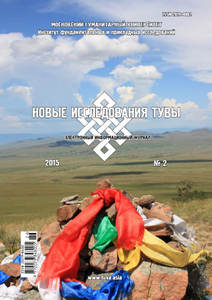The language policy and cultural building in the Tuvan People's Republic
Keywords:
Tuva; Tuvan People’s Republic; Mongolia; USSR; Comintern; state language; Mongolian language; written language; latinisation; language policyAbstract
Article is devoted to the role of the Mongolian language in Tuvan official sphere, education and mass-media during the initial years of Tuvan People’s Republic. Author investigates into the disputes of language choice for the Tuvan educational institutions and the issue of the Tuvan written language creation (1920’s). It proves that the lingual and educational spheres’ modernization had been influenced by the trends in the USSR language policy as well as the decision of Soviet diplomacy and Comintern to lead Tuva gradually out of the Mongolian influence. Article reveals the unknown and little-known facts of cultural and educational development of the Tuvan People’s Republic.References
Adrianov, A. V. (2007) Puteshestvie na Altaj i za Sajany, sovershennoe v 1881 godu (izvlechenija) // Urjanhaj. Tyva depter: antologija nauchnoj i prosvetitel'skoj mysli o drevnej tuvinskoj zemle i ee nasel'nikah, ob Urjanhae — Tannu-Tuve, urjanhajcah — tuvincah, o drevnostjah Tuvy : v 7 t. /sost. S. K. Shojgu. M. : Slovo. T. 3: Urjanhajskij kraj. Tuvinsko-russkie otnoshenija (nachalo XVII — nachalo XX vv.).
Alpatov, V. M. (1993) Jazykovaja politika v SSSR v 20–30-e gody: utopija i real'nost' // Vostok. № 5. S. 113–127.
Alpatov, V. M. (1997) 150 jazykov i politika 1917–1997. Sociolingvisticheskie problemy SSSR i postsovetskogo prostranstva. M. : Institut vostokovedenija RAN.
Bicheldej, K. A. (2010) 80 let tuvinskoj pis'mennosti: stanovlenie, razvitie, perspektivy [Jelektronnyj resurs]// Novye issledovanija Tuvy. Jelektronnyj informacionnyj zhurnal. № 4. URL: http://www.tuva.asia/journal/issue_8/2544-bicheldey.html(data obrashhenija: 12.04.2015).
Vladimircov, B. Ja. (1989) Sravnitel'naja grammatika mongol'skogo pis'mennogo jazyka i halhaskogo narechija. Vvedenie i fonetika. M. : Nauka.
Istorija Tuvy (2007) M. : Nauka. T. 2.
Kan, V.S. (2009a) Vozniknovenie i razvitie gazetnoj pressy na staromongol'skom jazyke v Tuve (1925–1929 gg.) [Jelektronnyj resurs] // Novye issledovanija Tuvy. № 4. URL: http://www.tuva.asia/journal/issue_4/918-kan.html(data obrashhenija: 12.04.2015).
Kan, V.S. (2009b) Osobennosti sozdanija i razvitija periodiki na staromongol'skom jazyke v TNR (1925–1929 gg.) // Mongush Bujan-Badyrgy — osnovatel' Tuvinskoj gosudarstvennosti:Materialy respublikanskoj nauchno-prakticheskoj konferencii, posvjashhennoj 115-letiju so dnja rozhdenija Mongusha Bujan-Badyrgy. Kyzyl : Nacional'nyj muzej Respubliki Tyva. S. 151–155.
Kuular, E. M. (2012) Jugo-vostochnyj dialekt tuvinskogo jazyka. Kyzyl : Tuvinskij gos. un-t.
Lunacharskij, A. V. (1930) Latinizacija russkoj pis'mennosti. V kn.:Kul'tura ipis'mennost' Vostoka. Kn. 6. [Jelektronnyj resurs] // Nasledie A. V. Lunacharskogo. URL: http://lunacharsky.newgod.su/lib/raznoe/latinizacia-russkoj-pismennosti(data obrashhenija: 12.04.2015).
Maslov, P. P. (1933) Konec Urjanhaja. [Putevye ocherki]. M. : OGIZ; Molodaja gvardija.
Machavariani, V., Tret'jakov, S. (1930) V Tannu-Tuvu. M. ; L. : Molodaja gvardija.
Mollerov, N. M. (2013) O smene vlastnoj jelity i politicheskogo kursa v konce 1920-h godov v svjazi s kitajskimi i mongol'skimi sobytijami // Vestnik Tuvinskogo gosudarstvennogo universiteta. Social'nye i gumanitarnye nauki. № 1. S. 24–37.
Mongush, M. V. (2010) Tuva vek spustja posle Karrutersa i Menhen-Hel'fena. Osaka: Nacional'nyj Muzej Jetnologii.
Oshurkov, V. A. (2007) Iz stranstvovanij po zemle Urjanhov // Urjanhaj. Tyva depter: antologija nauchnoj i prosvetitel'skoj mysli o drevnej tuvinskoj zemle i ee nasel'nikah, ob Urjanhae — Tannu-Tuve, urjanhajcah — tuvincah, o drevnostjah Tuvy : v 7 t. /sost. S. K. Shojgu. M. : Slovo. T. 3: Urjanhajskij kraj. Tuvinsko-russkie otnoshenija (nachalo XVII — nachalo XX vv.).
Pal'mbah, A. (1935) K prazdniku nacional'noj kul'tury v Tuve // Revoljucionnyj Vostok. № 2 (30). S. 162–173.
Prokof'eva, E. D. (2011) Process nacional'noj konsolidacii tuvincev. SPb. : Nauka.
S. M. (1932) Kul'turnoe stroitel'stvo Tuvinskoj aratskoj respubliki // Revoljucionnyj Vostok. № 1–2 (13–14). S. 325–334.
Samdan, A. A. (2001) Mongolojazychnye istochniki po istorii Tuvy: avtoref. dis. … kand. ist. Nauk. M.
Tatarincev, B. I. (1976) Mongol'skoe jazykovoe vlijanie na tuvinskuju leksiku. Kyzyl : Tuvinskoe knizhnoe izdatel'stvo.
Ulanova, A. Je. (1988) Osobennosti mongol'skogo jazyka jugo-vostochnoj Tuvy: avtoref. diss. ... kand. filol. n. Ulan-Udje.
Published
How to Cite
Issue
Section

Author(s) license holder(s) grant rights for their work to the journal (grantee of a license) under the simple non-exclusive open license in accordance with Art. 1286.1 «Open license for a research work, work of literature or fine arts», Civil Code of the Russian Federation.
New Research of Tuva publishes articles under the Creative Commons Attribution-NonCommercial license (CC BY-NC).
Since it is an open license, author(s) reserve the right to upload the article to their institutional repository, submit it to another journal (if it allows republications), or republish it on their own website (in full, or in part).
However, several conditions apply here:
a) The republished version must always contain the name(s) and affiliation(s) of the author(s), the original title and the hyperlink to the original version on the New Research of Tuva website;
b) It must be in open access, free of charge, and no category of readers must be in any way whatsoever advantaged over general readership.
c) should the contribution be submitted elsewhere by its author(s) without substantial modification (30% or more of original text unchanged), the body of the article should contain a disclaimer that the original version was published in New Research of Tuva (with a link to the respective page)
The CC-BY-NC is a non-revocable license which applies worldwide and lasts for the duration of the work’s copyright.




